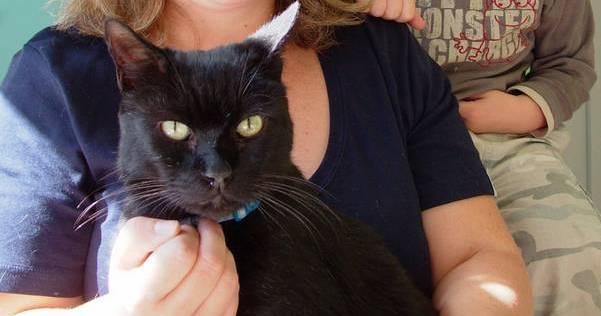Chico is a large, striking-looking black cat with yellow eyes. His owner Rhona knows him very well, and over a period of a few weeks recently, she had noticed that there was something not right about him. She could not put her finger on exactly what was wrong, but she just knew that he was not himself, so she brought him in to see me.
An owner’s intuition is one of the most sensitive barometers of a pet’s health. If you live with an animal, you become tuned in to their daily routines and behaviour. When a pet is unwell, the first sign of illness is often so subtle that a casual observer would not notice anything amiss. But as a pet owner, it may be very obvious to you that something has changed, and that your pet is “not their normal self”. If you do feel this, it is best to go to the vet for a more detailed examination of what is going on. Early diagnosis and treatment of illnesses can make the difference between life and death in some cases.
When Chico arrived at my surgery, he seemed very bright and cheerful. He purred, and pushed his head against my hand in a friendly way. Before examining him properly, I asked Rhona some questions.
Rhona’s main concern was that Chico was just not behaving as he normally did. When I questioned her closer, she told me that he seemed to have less energy than before, and was lying around the house more than usual. She thought that he had lost weight, and when I put him on the electronic scales, this was confirmed. He was still a big cat, at over 6kg, but he had lost 10% of his body weight since his last visit. This was the equivalent of a ten stone person going down to nine stone.
Despite the weight loss, Rhona felt that Chico had developed a pot belly, and I agreed that he seemed to be “rounder” than before. Some of this could be due to old age – cats develop middle-aged spread in the same way as humans. When I poked and prodded his abdomen, I could not feel any lumps or bumps, and there was no discomfort. Chico simply had a bigger, more swollen belly than before.
I asked Rhona some other questions about Chico’s daily life, but there was not much else amiss. He was eating well, he had no digestive upsets, and he never coughed. When I asked if he was drinking more than usual, she was not sure. Like many cats, Chico was quite private about his drinking habits. He spent most of his days out and about, presumably drinking from puddles and ponds. But when Rhona thought about it, she did think that she had seen him at his water bowl more often recently.
When I examined Chico, I could find nothing wrong other than his pot belly. His heart and lungs were healthy, and in general, he was in good condition for his age. I decided to take a blood sample to do a general profile on his metabolism, and in the mean time, I gave him a thorough worm dose. Chico was a hunter, and it was possible that worms could be the cause of the weight loss.
The blood results were almost completely normal when they came back a few days later. But there was one abnormality, and it was very significant. Chico had an elevated blood glucose, suggestive of diabetes. Just like in humans, diabetes develops in cats when the pancreas stops producing the hormone insulin. Diabetes used to be very rare in cats, but it is seen with increasing frequency in the modern generation of well fed felines.
In Chico’s case, the blood glucose was only slightly higher than normal, so I needed more evidence before I could confirm the diagnosis. I sent Rhona on a quest for a urine sample, but Chico did not like using a litter tray, and he certainly would not pee on request into a sample bottle. Instead, a week later, Rhona brought him in for a repeat blood sample. His blood glucose was even higher now, and the diagnosis was confirmed – Chico was diabetic.
Treatment of diabetes in cats can only be done in one way: injections of insulin. Rhona was nervous about this at first – like most owners, she had no experience of giving injections, and she was worried about Chico’s reaction to being stuck with a needle. Luckily the needles are so fine, and the amount to be injected is so small that most cats barely even notice. I gave Rhona a demonstration, and she practiced at home by injecting an orange before starting on Chico himself. After the first few days, the new routine was established, and Rhona now has no difficulties at all giving Chico his twice daily insulin injections. He is also being fed a new diet, designed specifically for diabetic cats.
Chico returned to “his old self” within a few days, but it will take a few weeks until his diabetes has been fully stabalised. He will need blood tests several times a year, but he will continue to live a normal active life – hopefully for many more years to come.
Tips
- Diabetes is much more common in cats than it used to be
- Increased thirst and weight loss are the main signs of diabetes
- Several blood tests may be needed to confirm the diagnosis

